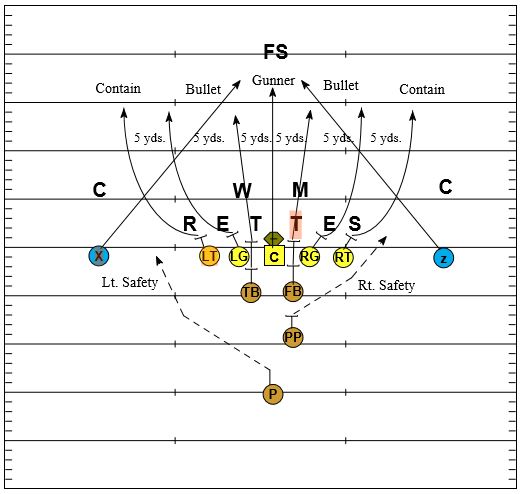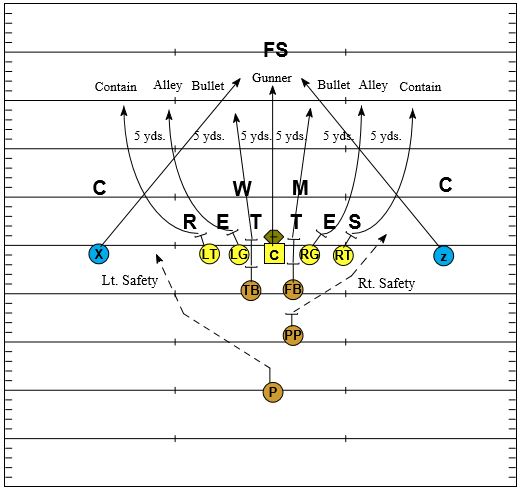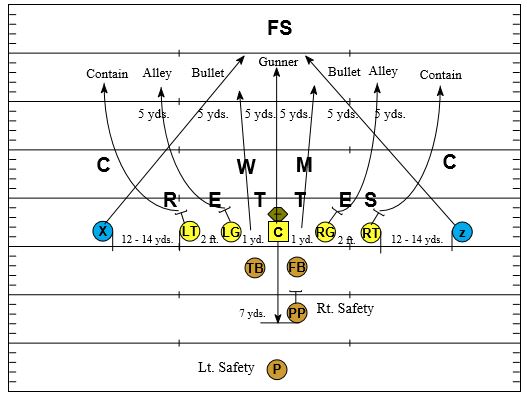The punt team must develop expertise, precision and teamwork. Again, the talents of the snapper, punter and gunners will directly impact the types of schemes that will be used during a season. We must always gain forty (40) yards of field position when we punt. Field position is a critical factor to success in any game. The punt team generally creates field position through coverage and/or punt placement [pooch or directional punt]. The effectiveness has a direct impact on the type of offense or defense that can be used. George Allen said, “I emphatically believe that the punt is the most important play in football!”
Here is a brief recap of the importance of the punt:
A sizeable amount of yardage is exchanged.
There is a change in possession during live play.
“It creates field position for the defense “There is a momentum shift with a great punt, big hit or a turnover.
Field position can lead to momentum which can be turned into points, that can lead to victory.
Our punt approach is to stress the return team through formation and kick placement. We use a spread punt alignment because we feel it limits the types of rushes we see. We feel that the spread punt alignment gives us the greatest chance to gain a field position advantage.
Some of the reasons include:
Utilization of personnel – use our skill players who can protect and cover.
Stress the return team – this formation eliminates many of the traditional punt block schemes because of the potential fakes. Also, getting into the return schemes are slowed down because the return team must
Check” for fake first.
Strong coverage – gunners are key, and interior coverage is excellent because the return team is spread out.
Precise protection rules – the protection scheme is well defined, and the players should have a clear picture of who to block.
Punt Protection and Cover

The punt alignment and Protection is based upon man blocking principles, with a zone scheme in an overload situation. We are going to directional kick for many of the same reasons detailed in the proceeding chapter. A directional kick, should take half the field away which allows our gunners to take specific aiming points. In general we want to kick away from a single returner. If our opponents have two (2) returners, we will consider a fake, and then we want to kick it as high and deep as possible.

Coaching Points: The depth off the LOS while maintaining a solid wall as the linemen execute their blocks is critical to the integrity of the protection scheme. Blocked punts are the result of missed blocks. Drill bad snap situations and how to take a safety. Versus a hold-up return scheme, the blockers must use a “dip and rip” to free themselves. The bullets and center (gunner) create a triangle or “net” as they converge on the ball carrier.
Tight Punt Protection & Release

The snapper and punter are always important, but when in a tight punt situation the margin of error becomes very small. The punter must catch the ball. If they do drop it, they must fall on the ball and the team will give up the safety (two points). They must avoid giving up the touchdown (six points). Also, practice with your punters on how to take an intentional safety. Do not just talk to your punter about these situations – coach them. Talk football with them, and then drill the situations on the practice field. Then when the situation arises game night, you have a foundation to go over and remind them of the process.
Coaching Points For Tight Punt Blocking technique is still inside-outside-inside; however stay with man until they are forced outside. There can be no inside penetration. Coverage assignments remain the same after protection is secure. Drill the punter on how to take a safety.
Punt Alignment & Technique

STANCE: Feet are shoulder width apart, taking a heel-toe-stagger with inside foot up; and the hands set lightly on the thigh pads with shoulders parallel; i.e., keep the chest big and eyes up to scan the defense.
ALIGNMENT Guard and tackle splits are 18 to 24 inches. The guard’s helmet must break the plane of the center’s belt (or bottom of his numbers); i.e. set off the line of scrimmage (“LOS”) as far as legally possible. Tackles will take alignment parallel with the guards.
The Up Backs inside foot will split the difference between the Center and Guard at a depth of 1 yard off the L.O.S. To insure proper depth, the Up Backs should be able to reach out and touch the near hip of the Center.
About the Author of this post:
Jerry Campbell has over 30 years of high school and college coaching experience. He has experience as a head coach, offensive coordinator, and various position coaches. He has written numerous football coaching articles in various publications, is the author of over 30 books on coaching football, and has produced 12 coaching video series. Additionally, he is a nationally sought after speaker on the coaching clinic circuit.